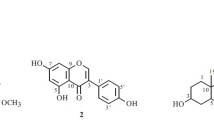Abstract
Crude extracts of the root of the resistant legume,Lupinus angustifolius, showed feeding deterrent activity toCostelytra zealandica andHeteronychus arator larvae. Nine 5-hydroxyisoflavones were isolated from an active fraction and their feeding deterrent activity and antifungal activity was measured. High feeding-deterrent activity was associated with high antifungal activity with some exceptions.
Similar content being viewed by others
References
Bailey, J.A., andBurden, R.S. 1973. Biochemical changes and phytoalexin accumulation inPhaseolus vulgaris following cellular browning caused by tobacco necrosis virus.Physiological Plant Pathol. 3:171–177.
Barnard, C. 1972.Lupinus angustifolius L. cv. “Uniharvest,” pp. 177–178,in Register of Australian Herbage Plant Cultivars. Division of Plant Industry, CSIRO, Australia.
Barz, W., andHoesel, W. 1979. Metabolism and degradation of phenolic compounds, pp. 339–369,in T. Swain, J.B. Harborne, and C. Van Sumere (eds.). Biochemistry of Plant Phenolics, Recent Advances in Phytochemistry, Vol. 12, Plenum Press, New York.
Bentley, M.D., Leonard, D.E., Reynolds, E.K., Leach, S., Beck, A.B., andMurakoshi, I. 1984. Lupine alkaloids as larval feeding deterrents for spruce budworm,Choristoneura fumiferana (Lepidoptera: Tortricidae).Ann. Entomol. Soc. Am. 77:398–400.
Biggs, R.1975. Post-infectional compounds from the french beanPhaseolus vulgaris; isolation and identification of genistein and 2′,4′,5,7-tetrahydroxyisoflavone.Aust. J. Chem. 28:1389–1392.
Bonde, M.R., Millar, R.L., andIngham, J.L. 1973. Induction and identification of sativan and vestitol as two phytoalexins fromLotus corniculatus.Phytochemistry 12:2957–2959.
Bradbury, R.B., andWhite, D.E. 1951. The chemistry of subterranean clover. Part I. Isolation of formononetin and genistein.J. Chem. Soc. 3447–3449.
Cantot, P., andPapineau, J. 1983. Discrimination des lupins à basse teneur en alcaloides par les adultes deSitona lineatus L. (Col. Curculionidae) 3:937–940.
Deshpande, V.H., Pendse, A.D., andPendse, R. 1977. Erythrinins A, B, and C: Three new isoflavones from the bark ofErythrina variegata.Indian J. Chem. 15B:205–207.
Farrell, J.A.K., andStufkens, M.W. 1977. Resistance to the grass grubCostelytra zealandica (White) (Coleoptera: Scarabaeidae) in some crop plant species.N.Z. J. Agric. Res. 20:503–505.
Farrell, J.A.K., andSweney, W.J. 1974. Plant resistance to the grass grubCostelytra zealandica (Coleoptera: Scarabaeidae) III. Resistance inLotus andLupinus.N.Z. J. Agric. Res. 17:69–72.
Fukui, H., Egawa H., Koshimizu, K., andMitsui T., 1973. A new isoflavone with antifungal activity from immature fruits ofLupinus luteus.Agric. Biol. Chem. 37:417–421.
Harborne, J.B., Ingham, J.L., King, L., andPayne, M. 1976. The isopentenyl isoflavone luteone as a preinfectional antifungal agent in the genusLupinus.Phytochemistry 15:1485–1487.
Ingham, J.L., andDewick, P.M. 1980. Sparticarpin: A pterocarpan phytoalexin fromSpartium junceum.Z. Naturforsch. 35c:197–200.
Ingham, J.L., Keen, N.T., andHymowitz, T. 1977. A new isoflavone phytoalexin from fungus-inoculated stems ofGlycine wightii.Phytochemistry 16:1943–1946.
Ingham, J.L., Tahara, S., andHarborne, J.B. 1983. Fungitoxic isoflavones fromLupinus albus andother Lupinus species.Z. Naturforsch. 38c:194–200.
Kinoshita, T., Saitoh, T., andShibata, S. 1978. A new isoflavone from licorice root.Chem. Pharm. Bull. 26:141–143.
Lane, G.A., andNewman, R.H. 1986. Isoflavones fromLupinus angustifolius root. Phytochemistry 25: in press.
Lane, G.A., Biggs, D.R., Russell, G.B., Sutherland, O.R.W., Williams, S.M., Maindonald, J.H., andDonnell, D.J. 1985. Isoflavonoid feeding deterrents forCostelytra zealandica Structure-activity relationships.J. Chem. Ecol. 11:1713–1735.
Ma, W.C. 1976. Mouth parts and receptors involved in feeding behavior and sugar perception in the African armywormSpodoptera exempta (Lepidoptera: Noctuidae).Symp. Biol. Hung. 16:139–151.
Ollis, W.D. 1962. The Isoflavonoids, pp. 353–405,in T.A. Geissman (ed.). The Chemistry of Flavonoid Compounds. Pergamon Press, Oxford.
Ruiz, L.P. 1978. Alkaloid analysis of “sweet” lupin seed by GLC.N.Z. J. Agric. Res. 21:241–242.
Russell, G.B., Sutherland, O.R.W., Hutchins, R.F.N., andChristmas, P.E. 1978. Vestitol: A phytoalexin with insect feeding-deterrent activity.J. Chem. Ecol. 4:571–579.
Russell, G.B., Sutherland, O.R.W., Lane, G.A., andBiggs, D.R. 1979. Is there a common factor for insect and disease resistance in pasture legumes? pp. 95–97,in T.K. Crosby, and R.P. Pottinger (eds.). Proceedings of the 2nd Australasian Conference on Grassland Invertebrate Ecology. Government Printer, Wellington.
Skipp, R.A., andBailey, J.A. 1976. The effect of phaseollin on the growth ofColletotrichum lindemuthianum in bioassays designed to measure fungitoxicity.Physiol. Plant Pathol. 9:253–263.
Skipp, R.A., andBailey, J.A. 1977. The fungitoxicity of isoflavanoid phytoalexins measured using different types of bioassay.Physiol Plant Pathol. 11:101–112.
Sutherland, O.R.W., andGreenfield, W.J. 1978. Effect of root extracts of resistant pasture plants on the feeding and survival of black beetle larvae,Heteronychus orator (Scarabaeidae).N.Z. J. Zool. 5:173–175.
Sutherland, O.R.W., Russell, G.B., Biggs, D.R., Lane, G.A. 1980. Insect feeding deterrent activity of phytoalexin isoflavonoids.Biochem Syst. Ecol. 8:73–75.
Tahara, S., Ingham, J.L., Nakahara, S., Mizutani, J., andHarborne, J.B. 1984a. Fungitoxic dihydrofuranoisoflavones and related compounds in white lupin,Lupinus albus.Phytochemistry 23:1889–1900.
Tahara, S., Nakahara, S., Mizutani, J., andIngham, J.L. 1984b. Fungal transformation of the antifungal isoflavone luteone.Agric. Biol. Chem. 48:1471–1477.
Tahara, S., Nakahara, S., Mizutani, J., andIngham, J.L. 1985. Fungal metabolism of the prenylated isoflavone licoisoflavone A.Agric. Biol. Chem. 49:2605–2612.
Wallace, C.R. 1945. The black beetle (Heteronychus sanctae-helenae). As it affects coastal vegetable growers and horticulturalists.Agric. Gaz. N.S. W. 56:339–342, 348.
Whalley, W.B.1957. 5:4′-Dihydroxy-8-methylisoflavone, and a note on lotoflavin.J. Chem. Soc. 1833–1837.
Wink, M., Hartmann, T., Witte, L., andReinheimer, J. 1982. Interrelationship between quinolizidine alkaloid producing legumes and infesting insects: exploitation of the alkaloid-containing phloem sap ofCytisus scoparius by the broom aphidAphis cytisorum.Z. Naturforsch. 37c:1081–1086.
Woodward, M.D. 1979. Phaseoluteone and other 5-hydroxy-isoflavonoids fromPhaseolus vulgaris.Phytochemistry 18:363–365.
Author information
Authors and Affiliations
Rights and permissions
About this article
Cite this article
Lane, G.A., Sutherland, O.R.W. & Skipp, R.A. Isoflavonoids as insect feeding deterrents and antifungal components from root ofLupinus angustifolius . J Chem Ecol 13, 771–783 (1987). https://doi.org/10.1007/BF01020159
Received:
Accepted:
Issue Date:
DOI: https://doi.org/10.1007/BF01020159




